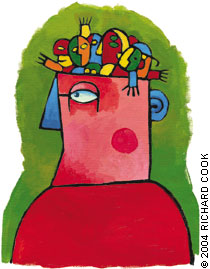
Unseen family phantoms can accompany you and your patients into the exam room.
Fam Pract Manag. 2004;11(7):70

Family medicine promotes caring for the patient within the context of the family. While family members may not physically accompany a patient into the exam room, many physicians realize the family’s influence is omnipresent. Gaining the family’s support while maintaining your focus on what’s best for the patient can be a delicate balancing act. Consider the following key questions, which will help you maneuver among the family dynamics that influence the physician-patient relationship.
1. What are the family’s past medical experiences? Does the family have a history of positive or negative interactions with physicians and the health care system? I once knew a father and son who believed that a physician was the cause of their wife/mother’s death. Their experience will certainly make any future encounters with physicians more difficult.
2. What stressors are impacting the patient’s family? Families go through various stages and phases. Birth, death, illness, marriage and divorce are just some of the events that can throw a family into transition. During these times, families often get stuck emotionally or experience intense stress. For example, being a caretaker of a parent with Alzheimer’s may be causing a patient’s irritability with you or your office staff. Being aware of major family events will help you to better empathize with and care for your patients.
3. Where did that zinger come from? When the intensity to an interaction is greater than normal or when you get blindsided by a patient’s anger or other emotions, consider whether conflicts and concerns from the family are spilling over into the office visit. For example, you may be catching the leftover emotion of an argument a patient had with his or her spouse that morning.
4. What are the family’s medical beliefs? Does this family have a rule that you don’t see a physician unless you are on your deathbed? How does this family explain illness (e.g., God’s way of punishing people, the result of bad behaviors, or the sick person’s own fault)? A family’s medical beliefs will color how your patient interacts with you.
5. Who in the family is the “health expert”? Almost every family has an unofficial health expert who plays a vital role in the family’s health habits and behaviors. While he or she may not have any formal medical education, this is the person you want on your side – or at least want to know about. If this family member’s advice contradicts yours, guess whose advice will likely be ignored?
6. What does the family expect from you? Do they consider you a member of their family? Do they keep you at a distance? Do they share secrets with you? Do they expect you to be constantly available to them? Are their expectations realistic? How do their expectations fit with your expectations? What can be done to bridge any differences in expectations that may be leading to disappointment? Discrepant expectations can lead to misunderstandings, confusion and disagreements. Knowing what the patient and the family of the patient expect provides a starting point for clearer communication and negotiation and, thus, enhanced care and compliance.
7. Who in your own family is an unseen presence in the exam room? We may think that physicians and medical professionals are above countertransference, but all of us bring our past relationships into the patient encounter to some degree. Something as simple as a lack of sleep can make us overly reactive to our emotions. During these times, our own past relationships and relational situations may heavily influence our interactions with patients. When we are overly reactive or too intense, it should signal to us that we need to take a step back and get a grip. This may mean politely disengaging and leaving the room for a minute.
A step in the right direction
Maneuvering among phantom family members in the exam room is an intricate dance, but one you can learn to do by asking the questions above. The first step is to become aware of their unseen presence. Only by acknowledging the influence family members have on our patients can we prevent ourselves from inadvertently stepping on someone’s toes.